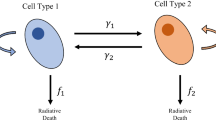Abstract
A mathematical model for combination of radio- and anti-angiogenic therapy is considered as optimal control problem with the objective of minimizing the tumor volume subject to isoperimetric constraints that limit the total radiation dose and the overall amount of anti-angiogenic agents to be given. The dynamics combines a model for tumor development under angiogenic inhibitors with the linear-quadratic model for the damage done by radiation ionization. The system has been investigated analytically as an optimal control problem and explicit expressions for possible singular controls were derived before. In this paper, for varying total radiation doses, examples of numerically computed optimal controls are given that verify and confirm these analytical structures: optimal schedules for the anti-angiogenic agents typically start with a brief full-dose segment, and then use up all inhibitors along a time-varying singular control while optimal radiotherapy schedules intensify the dosing and, after a brief period when the control is singular, end with a maximum dose segment. Singular controls occur for both the anti-angiogenic and radiotherapy dose rates. A discussion of the difficulties in proving the strong local optimality of corresponding trajectories is included.








Similar content being viewed by others
References
Kerbel, R.S.: Tumor angiogenesis: past, present and near future. Carcinogensis 21, 505–515 (2000)
Jain, R.K.: Normalizing tumor vasculature with anti-angiogenic therapy: a new paradigm for combination therapy. Nat. Med. 7, 987–989 (2001)
d’Onofrio, A., Ledzewicz, U., Maurer, H., Schättler, H.: On optimal delivery of combination therapy for tumors. Math. Biosci. 222, 13–26 (2009). https://doi.org/10.1016/j.mbs.2009.08.004
Ergun, A., Camphausen, K., Wein, L.M.: Optimal scheduling of radiotherapy and angiogenic inhibitors. Bull. Math. Biol. 65, 407–424 (2003)
Hahnfeldt, P., Panigrahy, D., Folkman, J., Hlatky, L.: Tumor development under angiogenic signaling: a dynamical theory of tumor growth, treatment response, and postvascular dormancy. Cancer Res. 59, 4770–4775 (1999)
Chudej, K., Huebner, D., Pesch, H.J.: Numerische Lösung eines mathematischen Modells für eine Optimale Krebskombinationstherapie aus Anti-Angiogenese und Strahlentherapie. ASIM, Dresden (2016)
Ledzewicz, U., Schättler, H.: Multi-input optimal control problems for combined tumor anti-angiogenic and radiotherapy treatments. J. Optim. Theory Appl. 153, 195–224 (2012). https://doi.org/10.1007/s10957-011-9954-8
Aronna, M.S., Bonnans, J.F., Dmitruk, A.V., Lotito, P.: Quadratic order conditions for bang-singular extremals. Numer. Algebra Control Optim. 2(3), 511–546 (2012). https://doi.org/10.3934/naco.2012.2.511
Felgenhauer, U.: Structural stability investigation of bang-singular-bang optimal controls. J. Optim. Theory Appl. JOTA 152(3), 605–631 (2012)
Poggiolini, L., Stefani, G.: Bang-singular-bang extremals: sufficient optimality conditions. J. Dyn. Control Syst. 17(4), 469–514 (2011)
Poggiolini, L., Stefani, G.: Strong local optimality for bang-bang-singular extremals in single input control problems. IFAC PapersOnLine 50(1), 6128–6133 (2017). https://doi.org/10.1016/j.ifacol.2017.08.2022
Ledzewicz, U., Schättler, H.: Anti-angiogenic therapy in cancer treatment as an optimal control problem. SIAM J. Control Optim. 46, 1052–1079 (2007)
Schättler, H., Ledzewicz, U.: Optimal Control for Mathematical Models of Cancer Therapies. Springer, Berlin (2015)
Fowler, J.F.: The linear-quadratic formula and progress in fractionated radiotherapy. Br. J. Radiol. 62, 679–694 (1989)
Kellerer, A.M., Rossi, H.H.: The theory of dual radiation action. Curr. Top. Radiat. Res. Q. 8, 85–158 (1972)
Thames, H.D., Hendry, J.H.: Fractionation in Radiotherapy. Taylor and Francis, London (1987)
Pontryagin, L.S., Boltyanskii, V.G., Gamkrelidze, R.V., Mishchenko, E.F.: The Mathematical Theory of Optimal Processes. MacMillan, New York (1964)
Bonnard, B., Chyba, M.: Singular Trajectories and Their Role in Control Theory, Mathématiques & Applications, vol. 40. Springer, Paris (2003)
Bressan, A., Piccoli, B.: Introduction to the Mathematical Theory of Control. American Institute of Mathematical Sciences, Springfield (2007)
Liberzon, D.: Calculus of Variations and Optimal Control Theory. Princeton University Press, Princeton (2012)
Schättler, H., Ledzewicz, U.: Geometric Optimal Control, Interdisciplinary Applied Mathematics, vol. 38. Springer, New York (2012)
Haynes, G.W.: On the Optimality of a Totally Singular Vector Control. National Aeronautics and Space Administration, Washington D.C (1965)
Fourer, R., Gay, D.M., Kernighan, B.W.: AMPL: A Modeling Language for Mathematical Programming. Duxbury Press, Brooks-Cole Publishing Company, Plymouth (1993)
Wächter, A., Biegler, L.T.: On the implementation of an interior-point filter line-search algorithm for large-scale nonlinear programming. Math. Program. 106, 25–57 (2006). (cf. IPOPT home page (C. Laird, C., Wächter, A.): https://projects.coin-or.org/Ipopt)
Büskens, C.: Optimierungsmethoden und Sensitivitätsanalyse für optimale Steuerprozesse mit Steuer- und Zustands-Beschränkungen, Dissertation, Institut für Numerische Mathematik, Universität Münster, Germany (1998)
Büskens, C., Maurer, H.: SQP-methods for solving optimal control problems with control and state constraints: adjoint variables, sensitivity analysis and real-time control. J. Comput. Appl. Math. 120, 85–108 (2000)
Maurer, H., Büskens, C., Kim, J.H.R., Kaya, Y.: Optimization methods for the verification of second-order sufficient conditions for bang-bang controls. Optim. Control Methods Appl. 26, 129–156 (2005)
Vossen, G.: Switching time optimization for bang-bang and singular controls. J. Optim. Theory Appl. 144, 409–429 (2000)
Ledzewicz, U., Maurer, H., Schättler, H.: Optimal and suboptimal protocols for a mathematical model for tumor anti-angiogenesis in combination with chemotherapy. Math. Biosci. Eng. (MBE) 8, 307–328 (2011)
Osmolovskii, N.P., Maurer, H.: Applications to Regular and Bang-Bang Control: Second-Order Necessary and Sufficient Optimality Conditions in Calculus of Variations and Optimal Control, SIAM Advances in Design and Control, vol. 24. SIAM Publications, Philadelphia (2012)
Fiacco, A.V.: Introduction to Sensitivity and Stability Analysis. Academic Press, New York (1983)
Büskens, C., Maurer, H.: Sensitivity analysis and real-time optimization of parametric nonlinear programming problems. In: Grötschel, M., Krumke, S.O., Rambau, J. (eds.) Online Optimization of Large Scale Systems, pp. 3–16. Springer, Berlin (2001)
Author information
Authors and Affiliations
Corresponding author
Additional information
This paper is dedicated to our friend Aram Arutyunov on the occasion of his 60th birthday.
Rights and permissions
About this article
Cite this article
Ledzewicz, U., Maurer, H. & Schättler, H. Optimal Combined Radio- and Anti-Angiogenic Cancer Therapy. J Optim Theory Appl 180, 321–340 (2019). https://doi.org/10.1007/s10957-018-1426-y
Received:
Accepted:
Published:
Issue Date:
DOI: https://doi.org/10.1007/s10957-018-1426-y
Keywords
- Optimal control
- Combination therapy
- Anti-angiogenic treatments
- Radiotherapy
- Numerical methods
- Arc parameterization




